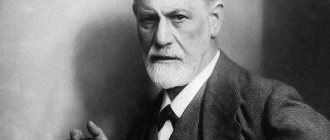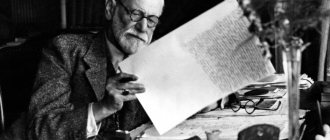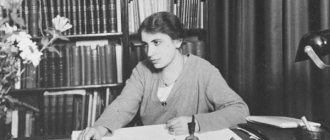- October 11, 2018
- Psychological terms
- Valeria Marutkova
Often doctors and psychologists working in the field of psychoanalysis use the term “mortido”, which in their work symbolizes the destructive principle in a person’s personality. In order to indicate the level of this feeling, they also use the term “destrudo”.
According to Freud, the individual is driven by two main instincts: libido and mortido. The first is a craving for life, the second is a destructive beginning.
Let's understand the meaning of these two terms and reveal what libido and mortido are in clear words.
What it is
Mortido energy is one of the two fundamental driving and motivating factors in all human expressions.
It is aimed at death and helps to distinguish everything that is unfamiliar, dangerous, possibly causing pain, i.e. on a subjective level, a person experiences these feelings as fear and potential danger, after which he nevertheless makes a choice towards contact with such energy. The mortido program is activated by unconscious mechanisms and has a great influence, despite the validity of the instinct for survival. Perhaps this is why in the broad theoretical field such a concept has not been consolidated widely and firmly, but is used only in borderline studies, where the researcher himself has the courage to come into contact with death and destructive tendencies, as well as the opportunity to recognize their necessity and important role in the formation of life. ways.
It is impossible to ignore the energy of death in a person’s mental space, since even at the biological level it has confirmation not only of its existence, but also of its direct influence on life. All types of animal aggression are interpreted as projective actions, in fact, an ongoing program of self-destruction. This is the basic level of manifestation of destructive energy - physical, characteristic of all living organisms.
As human consciousness develops, mortido begins to manifest itself at the biological level, when a person drives himself into depression, falls under the influence of various addictions, and also chooses a lifestyle that only leads to the degradation of basic psychoneurological functions. With a high proportion of projection, mortidosis energy is not appropriated and has little effect on the person himself, but begins to be actively produced into the external environment, triggering the highest level of its manifestation - social.
Here, both murder and verbal aggression, unlawful behavior, outbursts of discontent that are excessive in their emotional intensity, as well as the deliberate destruction of the social system as a safe system for the life of the entire species are possible.
Destructive force
At least, this is the opinion of psychoanalysts. After all, if a person does not project his mortido onto other people, then it begins to destroy him. Such cases occur frequently in psychotherapy. A person divorces a spouse who has terrorized him for a long time, or moves away from oppressive parents. It would seem that now a pleasant and free life should begin. However, such clients began to get sick and degrade as individuals. Since the object that hated them disappeared, the mortido energy began to destroy them.
This is why in psychotherapy clients are taught to cope with their emotions and redirect them towards creativity. Art therapy occupies an important place in psychology. Mortido is an energy that is most easily expressed in the form of images, music, dance. Then there will be no need to take out evil on others. By turning to creativity, a person stops destroying himself.
Isolation from the outside world
Not in the literal sense, when you buy buckwheat in huge quantities so as not to go out for several months. It could be a simple reluctance to leave the house anywhere other than to work or to the store.
Even knowing that it would really be very useful for you to unwind, take a break from the endless routine and finally see your friends over a glass of beer, you prefer to stay at home, finding reasonable reasons for this behavior. “I’m having health problems right now—I don’t want to be a burden to anyone” or “I bore them with my presence because I can’t have as much fun” are sure signs that all is not well.
Development of the death drive theory
The second dualistic theory was not recognized by most psychoanalysts during Freud's lifetime and was not sufficiently developed in the writings of psychoanalytic theorists after Freud's death.
Among Freud's students, only Alexander, Eitingon and Ferenczi accepted the idea of the death drive (Alexander later changed his mind). Subsequently, they were joined by P. Federn, M. Klein, K. Menninger, G. Nunberg and some others.
In his works, Sigmund Freud did not use the term “thanatos”, but used concepts such as “death instinct”, “drive to destruction”, “drive to aggression”, “drive to destruction”. However, in a conversation with biographer E. Jones, he used the word "thanatos". The term “thanatos” was first used within the framework of psychoanalysis by Wilhelm Stekel, but the term became widespread in psychoanalytic literature thanks to Paul Federn.
Karl Menninger, in his work “War with Oneself” (1938), examined various forms of self-destructive behavior, which he divided into suicide itself, chronic suicide (asceticism, martyrdom, neurasthenia, alcoholism, antisocial behavior, psychosis), local suicide (self-mutilation, simulation, polysurgery, intentional accidents, impotence and frigidity) and organic suicide (somatic diseases). In each of these cases, Menninger saw the presence of a death instinct.
Melanie Klein used the idea of the death drive to explore the mental dynamics of childhood. According to Klein, the feeling of anxiety is caused by the danger that the death drive exposes the body to. M. Klein also discovered the effect of the death drive in various childhood conflicts.
It is curious that the idea of the death drive was well received at the beginning of the century by Russian psychoanalysts (N. Osipov, Vinogradov, Golts). L. S. Vygotsky and A. R. Luria, who wrote the preface to the Russian translation of Freud’s work “Beyond the Pleasure Principle,” had a rather positive attitude towards the idea of the death drive. However, the persecution of psychoanalysis that began in the USSR after 1928 deprived for a long time the prospects for the serious development of psychoanalytic ideas.
Libido in Jung's theory
Swiss psychiatrist and teacher Carl Gustav Jung views libido somewhat differently. By this term he understands psychic energy as a whole, and defines sexuality as the possibility of manifestation of this energy, but in no case as its variety. According to Jung's point of view, libido is similar to the Eastern theory of qi or prana energy, that is, in his opinion, libido is the free energy of life.
In general, libido is the desire for creation and love, which originates in the unconscious of the individual as an instinct for the preservation of being and realization in creativity. This attraction is directly or indirectly aimed at releasing consciousness into reality, but in a positive way.
Destrudo is...
What is destrudo? These are destructive actions of a person aimed at himself or the world around him. It is distinguished from the death instinct only by direction and implementation. In simple words, mortido is an instinct, and destrudo is a specific action or state. Destrudo can be used as a way to decipher the patient's attitude and state of mind.
It is impossible to determine exactly the mood of human behavior and its motives. In addition, not all scientists, psychologists, and doctors share the theory of human duality. According to Freud's theory, the highest way of manifestation of libido is sexual intercourse, and mortido is murder. It is worth recognizing that one way or another, both of these instincts influence modern man with one force or another.
Energy of instincts
So, the term “destrudo” was used to denote the magnitude of the death instinct. The founder of the theory of mortido and libido was Freud, but he himself did little about it, but his students continued to work on research. They were based on a concept that assumed the duality of human personality. That is, in every personality, libido and mortido are the two main instincts that must be balanced and focused on creation for normal life. Otherwise, everything will turn into destrudo - destruction, aggression, depression.
Second dualistic theory of drives
So, Freud contrasted libido and mortido as the desire for life and the desire for death.
Psychiatrist student Sabina Spielrein, based on this theory, wrote her work “Destruction as the Cause of Formation,” which gave rise to a more in-depth study of the death drive. Spielrein draws a parallel in his work between mortido and deeply hidden masochism. Sabina believed that the desire to destroy one’s own personality stems from a deep-seated desire for death
In her doctoral dissertation, she drew attention to the fact that the conscious disintegration of personality and the desire for self-destruction often becomes a source of creative and social growth
Many scientists and psychologists (Spielrein, Jung, Adler, Scheckel) were engaged in research in search of an answer to the question of the human death drive, but only Sigmund Freud was able to collect all their thoughts and ideas into a specific concept and covered the topic in detail in the second dualistic theory of drive. In this work, he was able to reveal the connection between libido and mortido in psychology and for the first time contrasted them with each other.
Based on the work of Freud and Spielrein, the term “destrudo” gained popularity, which Paul Federn later studied.
Libido is...
Most people, when they hear the word “libido,” understand it as sexual attraction to a person, but this word has a much broader meaning. In psychology, libido is not only sexual desire, but also the instinct for maintaining life and creative energy.
The term was first introduced in 1868 by M. Benedict. Then it meant only sexual attraction. In his treatise, The Theory of Libido, Freud presented the drive as the center of the idea of psychoanalysis. Freud argued that because of libido, a person develops and grows, and it is this that is the reason for actions and desires. The author divided libido into three components: drive, impulse and object. By linking together sexual desires and sexual relations, we can talk about the unity of objects of desire.
In the second dualistic theory of drives, psychoanalyst Freud contrasted libido and mortido in psychology. This gave rise to research into the death instinct and destrudo. He began to consider the vital energy underlying sexual desires. The author did not associate the term only with sex, but tried to understand it in a broader sense, analyzing both love and passion. Freud believed that if the accumulated libidinal energy does not find its way out, it can lead to mental disorders.
At the same time, Carl Jung moved as far as possible from understanding the word “libido” as sexual desires and drew parallels with qi and prana, trying to find an explanation in the lifestyle of less developed peoples.
How does mortido work if mishandled?
From the point of view of psychologists, mortido pushes a person to two types of crimes - towards himself and towards others. The inability to cope with one’s own feelings causes conflicts, anger, and a desire to oppose oneself to the whole world. From the point of view of a crime against oneself, this is intoxication with negative experiences, manifestations associated with sadomasochism.
From all this, a person’s desire is born to do everything the other way around, contrary to the current situation. The meaning of human life becomes constant struggle. He is interested in conflict for the sake of conflict, and this is very sad. After all, in this way people destroy themselves, their bodies. Oncological diseases are often caused by inept handling of one's own emotions. Instead of turning unpleasant experiences into music, poetry or paintings, a person torments himself with unpleasant emotions. This cannot but affect the body.
Such people are so overwhelmed by anger that they become subject to sudden mood swings. Today they flutter with happiness, but tomorrow they are ready to destroy the whole world. Outbursts of anger are common. Any little thing can infuriate a person who mishandles mortido energy. This leads to disastrous consequences in terms of socialization. A person can go on a binge, using protest to try to prove that he wants to find his happiness.
How to recognize mortido
It manifests itself dashingly and without any fuss. The first sign visible to the naked eye is depression. Not just melancholy and sadness. And the anxiety that makes you want to die. Or kill others out of anger. And all thoughts are only about this - the destruction of the cause of the depressed state. It has two output forms:
- Outward: aggression is directed outward. For example, violence: vandalism, robberies, terrorist attacks, murders. The outward manifestation of mortido is the desire to destroy the external object of personal hatred.
- Inside. Occurs when there is no external outlet for aggression. In this case, the person directs it towards himself. There is self-flagellation, binges, drug addiction of all types and varieties, and suicides.
Mortido
Periods of development of S. Freud's doctrine of the unconscious
According to Freud, the human psyche is divided into three areas:
- Consciousness;
- Unconscious;
- Preconscious.
All three areas are in a state of continuous interaction, and the first two are also in a state of intense struggle among themselves. The mental life of a person, the scientist believes, comes down to precisely this interaction and struggle. Every human act and mental act must be considered as the result of a competition and struggle between consciousness and the unconscious.
The concept of the unconscious did not develop immediately and went through several periods:
The first period of Freud's concept. At this stage, the concept of the unconscious is very close to the teachings of such French psychiatrists and psychologists as Charcot, Liebeau, Janet, and one can say that it is directly genetically dependent on them; Second period. It is the longest and most important in the development of psychoanalysis. At this time, all the main and characteristic features of Freud’s teaching on the unconscious are determined, which becomes completely original
The unconscious becomes a necessary and important part of the mental apparatus of every person. The struggle between consciousness and the unconscious is declared to be a constant and natural form of mental life.
For all areas of cultural creativity, the unconscious becomes energy and a productive source of psychic forces. But the unconscious can also become the source of all nervous diseases. Thus, in the second classical period of psychoanalysis, the concept of the unconscious is enriched with a number of new, significant aspects. Third period. The concept changes significantly and comes closer to the metaphysical teachings of Schopenhauer and Hartmann. The unconscious becomes the embodiment of everything lower and everything higher in a person. A new division appears instead of the previous one:
- Sexual attraction or eros;
- Attraction to death.
The basis of all manifestations of aggressiveness, cruelty, murder and suicide are the death instincts.
The instinct of self-preservation has been transferred to sexual desires; it includes sub-instincts that make any organism alive:
- Nutrition;
- Height;
- Breath;
- Movement.
With the development of civilization, the instinct of self-preservation lost its significance and the instinct of reproduction or libido took first place.
Trying to penetrate the mechanisms of the human psyche, Freud proceeds from the fact that its natural, deep layer (“It”) functions according to an arbitrarily chosen program for obtaining the greatest pleasure. But the individual, in satisfying his passions, encounters a reality that contradicts “It”. This contradiction is associated with the isolation of the “I,” which seeks to curb unconscious drives and channel them into socially approved behavior.
The task of psychoanalysis formulated by Freud is to transfer the unconscious material of the human psyche into the realm of consciousness and subordinate it to its goals. In this regard, Freud was an optimist and believed in the ability to become aware of the unconscious.
The analytical activity of the scientist was aimed at ensuring that a person, as the nature of the unconscious is revealed, could master his passions and consciously manage them in real life.
Libido and mortido
Libido and mortido
- these are two forces, two drives that determine and frame a person’s movement along the corridor of life. Libido is an attraction to life, an attraction to change, it is the very manifestation of life, what supports it over time. But everything living in its manifestation of life is limited, that is, mortal, of course. Mortido is a force that limits libido, the attraction to a static state, to death as the primary state from which the inanimate was introduced into the state of life. Libido is the desire for a finite form of life (life in the body), and mortido is the desire for an infinite form of life (since we are talking about forces, mortido can be defined differently as the desire for a state that preceded the life of the body).
Man is the pleasure principle, the desire for pleasure. One of the central and basic drives of higher animals and humans is the desire to preserve oneself, a given form of life, body and psyche (in the case of humans). Another basic drive is reproduction, the desire to continue oneself in time, to transfer one’s gene pool into the future. In both man and animal these drives are unconscious; man, however, as a sensual and conscious form of life, is also capable of recognizing in himself certain mental manifestations, the consequences of these drives.
A person internally feels the interaction of two forces, libido and mortido, and, being under their influence, tries to find some balance in himself in order to preserve himself. He preserves himself thanks to the innate and acquired abilities to protect himself from harmful external influences and irritations, as well as due to the ability to extract pleasure and satisfaction from life, filling his vectorial mental needs with it. From the time of the primitive pack to the present day, food has been the main source of pleasure, and it also becomes the very essence of the connection between early man and the external environment. Nature controls the human species through a lack of food; man must and wants to eat. This lack forces him to act, forces the entire primitive pack to hunt collectively, which subsequently, when a person becomes a social form of life, leads to the emergence of a food hierarchy, within which the food obtained is divided and distributed by the urethral leader among all members of the pack. This is not an equal division, everyone receives according to their needs, according to their shortages and according to their natural rank in this pack. Correct ranking - according to the vector set and one’s ability to benefit the flock - and distribution of food among all members of the flock according to needs becomes the foundation of the human psyche, of man as a social form of life. Each person also receives a sense of security and safety - this is also a type of satisfaction - within the social group from the leader. The feeling of a sense of security and safety is a fundamental mental need of a person; without it, a person is not able to mentally preserve himself both in early childhood and in adulthood.
The drives of our “I” are extremely conservative; they constantly strive to return to a state of balance, trying to repeat the previously experienced satisfaction that gave this balance. The influence of the external environment is such that a person must constantly react to its changes and to irritations coming from outside in order to regain the lost, previously achieved mental balance. In addition, unfulfilled mental desires themselves (vector desires) are sources of internal irritation of the mental apparatus. After all, the emptiness of desire, having been filled with satisfaction, arises again after some time. This cycle of changing states in desires resembles the nature of vibrations.
The relationship between libido and mortido in humans
At birth and until the first year of life, libido almost completely predominates in a person, and mortido is present only as a kind of fulcrum for the process of life, rushing towards the original state, the inanimate state or, in other words, the state preceding life in the body. After all, a small child’s life (the power of life, that which enlivens) is formed during the first year, including the development of the volume of his individual psyche. A small child has a colossal amount of energy and strength, which gradually begins to be balanced by the desire for a static state. Life is the desire for movement, for the emanation of energy, for the effective use of the potential of psychic energy given by nature. However, inside living organic matter, this desire is limited by another desire - to completely balance the internal mental tension caused by desires, i.e., to work out the potential of desire given to an individual person, to exhaust its strength and volume with pleasures or appropriate filling, thereby achieving a primary static state. After the first year of life, the proportion of mortido begins to increase in the child’s sensations, and at some point an element appears in the perception of the environment that prevents the realization of one’s life through active action, in the form of laziness.
Man is the principle of pleasure, and he can receive pleasure both from action and effort, the investment of mental and physical strength, and from inaction, bliss, which, as we know, can also bring satisfaction. By the age of 15-17, a certain stable balance is achieved between libido and mortido in a person, in which he remains until the age of 25-27. After the age of 27, mortido begins to predominate more and more in life. Until the moment when mortido comes to its highest form and limits libido completely, leading to the end of life, loss of life energy, loss of attraction to vibration. This manifestation of the relationship between libido and mortido throughout life is typical for most people, except for urethral and muscular ones. In them the relationship between libido and mortido in the psyche is expressed differently. For the average cutaneous and anal man without serious delays in psychosexual development, the predominance of mortido is expressed in a decrease in sexual desire, he needs fewer sexual contacts per week than he had at a younger age. On average, a person becomes more difficult to lift, the desire for balanced inaction, rest begins to prevail in him, and he feels like a lack of strength for action.
Manifestations of mortido can be observed not only within the framework defined by the age corridors of life, but also, for example, in the form of a certain manifestation of the peculiar mercy of nature. A person is born with a certain potential of psychic energy, but if, making every possible effort to obtain pleasure and joy, he does not receive them over and over again, then the energy suppresses itself, a strong attraction to mortido, laziness, staticity occurs, and apathy and lack of interest arise and strength to live. Such conditions can occur in people as early as early adolescence.
Sexual attraction, which occupies a central place in the libidinal manifestations of the lower vectors, is especially interesting. At the biological level, sexual is the desire to reproduce the original (previously former) structure of a living substance in the form of an embryonic cell, but with the inherited and newly acquired abilities of a currently living organism. That is, this is the desire to preserve life itself for longer periods, as opposed to other desires that lead the body to death. In a man, this is mentally expressed in the form of a desire to give his ejaculate to a woman, while experiencing the brightest pleasure in life, sensually justifying all the hardships of existence leading to this peak pleasure. In a woman, psychologically, this is the desire to obtain a feeling of security and safety from intercourse with a man and receiving male ejaculate. It is the act of affirming the preservation of one's own life and affirming the continuation of one's life through time. Therefore, female nature as such is more about the desire to preserve the lives of both herself and her offspring. Therefore, all factors conducive to this are extremely important for her, including the properties and development of her life partner, who is more or less capable of satisfying these basic needs.
Features of libido and mortido of the muscle vector
In the muscle vector, i.e. in a purely muscular person, the ratio of libido and mortido is expressed exactly the opposite in comparison with other people. The muscle vector is mentally a set of basic desires: eat, drink, breathe, sleep and maintain your body temperature. The muscleman has a special mind, a special natural wisdom, which evolved evolutionarily as a human tool for self-preservation. Namely, the ability to generate thought forms about preserving one’s integrity through ensuring desires to eat, drink, breathe, sleep, supported by visually effective thinking.
A muscleman is not a person of intellectual labor, but in a special way he is naturally predisposed to incessant physical labor. This is the person least burdened by the conscious and egocentric form of feeling his own uniqueness (the opposite of him is the sound person), the person who is closest to the unconscious than others, the person who feels in a special way that he belongs to the pack, to the community. The muscleman, alone among people, has an internal sense of “we”. He does everything like everyone else - “like everyone else, so do I.” Because he feels himself, his “I”, as an inseparable part of a community, a collective, therefore his “I” is more of a feeling of “we” than a feeling of “I”. These are unique, yet simple forms of perception, not burdened with intellectual complexity and do not give rise to any philosophical speculations in the muscleman about the own nature of perception. Nevertheless, this is a small in volume and severity of manifestations, but a perfect and accurate form of perception of the presence of a mental connection, the mental integrity of people in general, of the human species. For a muscleman, the presence of this connection is manifested in a simple form of perception and is expressed, as it were, more physically; for him, a state of comfort is being shoulder to shoulder with a large number of people, in a close community. He does not think at all and does not define life outside the collective. And the greatest suffering comes from forced loneliness.
A muscleman is born with a feeling of “paradise” interrupted, since all his desires - to eat, drink, breathe, sleep and maintain body temperature - were completely satisfied in the womb before birth. Birth becomes for him a collapse of the state of absolute mental comfort and balance. A muscular person is the only one who feels his birth as the cessation of true, in his sensations, life, therefore he has a special perception of life and a special attitude towards death.
For him, killing, the destruction of integrity at all four levels of nature - inanimate, plant, animal and human - becomes an act of doing good. The species role of the musclefish is warrior and hunter. He easily takes someone else's life and easily gives his own. The muscleman experiences joy from the end of life, and he kills living things exclusively with good intentions, usually to feed others, the whole flock and himself. If this is the murder of a person, then it is committed for the sake of preserving the pack, and if we talk about the personal attitude towards taking an enemy away from life, then in the perception of the muscleman this is a good deed, this is the transfer of a person to the best of worlds. In his perception of the world, what is life for everyone, the attraction to life, is death for him, and what is death for others is for him the beginning of life. For a muscleman, life begins after death, and he joyfully brings this death to the living.
A muscleman has an amazing ability to receive great satisfaction from contracting muscles, his erogenous zone. Therefore, a muscleman is naturally very hardworking, works a lot physically, and is the only person for whom laziness is unnatural, that is, he is not lazy by nature and remains so until a very old age. A muscular person simply cannot live without work, even in old age he cannot live without working early in the morning somewhere in the field. Moreover, he can work without payment; for him, work itself is sensual payment. The main thing is to have a roof over your head and a plate of food.
As an example, this inverse relationship between libido and mortido in the muscle vector can be described as follows: in a muscleman, the desire for life (for change through receiving pleasure) becomes the desire for death (the desire and inclination to kill living things and the desire to die with valor on the battlefield), and the desire for a static state (for death, that is, what is clearly manifested in others by laziness) becomes a desire for life, that is, for work. Working from pick-up to lunch is just about a muscleman.
Manifestation mechanism
A destructive drive is activated when a person’s needs are not met. What needs are particularly closely related to mortido?
- The need for procreation.
- The need to acquire a certain status in a hierarchical system of relationships.
- The need for self-affirmation.
As a result, a person is in a depressed, melancholy state, he has a feeling of anxiety and fear, and thoughts of death appear.
We recommend: Who is a melancholic person?
Cathexis
Also, to better understand what mortido is, it is necessary to consider the concept of cathexis. This word refers to the direction of attraction. For example, if a person fell in love, it means that he cathected his attraction into the object of his choice. In other words, cathexis is the placement of the energy of attraction.
Psychologists believe that a person has a need to cathect not only libido, but also mortido. This suggests the following: people not only crave to love and be loved; perhaps we have a built-in need to hate and to be hated.
Possible reasons
Psychology says that the causes of self-destruction come from childhood. The child’s psyche is a reverent and gentle instrument that needs to be played skillfully. Although it may happen that the problem of self-destruction appears in adulthood. The reason for this may be the loss of a loved one or any stress experienced. So, let’s look at the reasons for self-destruction:
Lack of parental love and affection. The child is acutely sensitive to criticism and punishment, especially without explanation. Physical and sexual violence entails a number of consequences that leave a negative imprint on the rest of your life. False statements. For example, parents insist that they know better, that it is not time to make decisions yet. In adult life, it is difficult to readjust and understand that the time has come and it’s time to decide for yourself what you want. Incorrect self-assessment. If a child is constantly scolded and told about his worthlessness, self-esteem will never be adequate. Unjustified expectations. For every parent, their child is the best
It is important to understand that all children are different with different talents and abilities. If too much is demanded from a child and he does not live up to expectations, his psyche breaks down. Ban on feelings, emotions
The child cannot react to the situation as he sees fit. As a result, he withdraws into himself.
Parents, be vigilant and do not make such mistakes. And if you find problems in adulthood, do not despair, there are ways to stop self-destruction.
a brief description of
According to the classical theory of psychoanalysis, human personality is based on two fundamental drives: creative ( libido
) and destructive ( mortido
). Ego-libido is experienced as pleasantly familiar, while mortido is experienced as pain, potential danger and some unknown, fearful one.
Until now, not a single psychoanalyst, including Federn himself, has been able to create a model of a mental apparatus in which these two differently directed instincts and two opposite types of psychic energy would coexist. The concept of mortido and its associated destrudo concept have not been established in broad disciplinary circulation.
At the same time, despite the fact that modern biological observations do not confirm the existence of mortido, this concept constitutes a significant fragment of numerous theories of aggression, which interpret the latter as a projection of people’s innate self-destructive drive.
Another interpretation of mortido
There is another interesting feature associated with mortido. Freud believed that this energy could not only make physical death attractive to a person. The transition of a person to the form of existence after death for the unconscious is equivalent to existence before birth. Both the first and the second are non-existence. Life before birth and life after death are events of the same order. And therefore, the desire to merge with the mother into one whole, metaphorically to return to the blissful state before birth, which in psychoanalysis is called regression, can be regarded as mortido.
Physiology
It is assumed that the activation of mortido occurs as a result of unsatisfaction of basic biological needs (needs for reproduction, programs for social, material self-affirmation, increasing hierarchical status), initially this program gives a signal: instead of the release of endorphins - internal drugs (morphinomimetic peptides that give a feeling of happiness, cheerfulness , euphoria, self-confidence) - there is a release of enkephalins, which act on the mental continuum in exactly the opposite way - leading to a depressive state, a feeling of melancholy, fear and unwillingness to live.
Unconscious
This is the deepest and most significant layer of the human psyche. It represents a kind of repository of memories, emotions and instinctive impulses. Such manifestations at one time threatened consciousness so much that they were suppressed by man and pushed into this area by him. Nevertheless, this material, unconscious to the individual, largely determines his daily functioning. Those experiences that have moved into the area of the unconscious are inaccessible to human consciousness. Nevertheless, they have a certain influence on people's actions.
In his popular philosophy of the Ego, the Id, and the Superego, Freud distinguishes three types of unconscious. In a descriptive sense, it is not the subject of psychoanalysis. In the dynamic concept, the unconscious means a conflict that displaces experiences from consciousness. This area is also considered in a structural sense. At the same time, Freud notes that the unconscious operates according to special laws that can control mental activity. Among them:
- inability to distinguish between reality and fantasy;
- lack of time and principle of contradiction, etc.
As a result of many years of clinical observations, the Freudian concept of personality was created. “I”, “It” and “Super-I” in it became the designations of the three components of personality. Let's consider their description according to the theory of psychoanalysis.
How to get rid of self-criticism
First, accept the fact that you are tormenting yourself with unjustified accusations. The next step is to determine the reason for this. And only then try to get rid of the tendency to self-flagellation. How to do it?
Have a track record of achievement
If you have achieved goals and successfully completed projects behind you, it is easier for you to stop destroying yourself by self-digging. But this will only happen if these achievements are truly important to you. It happens that people achieve a lot in life, but remain dissatisfied with themselves. It's never enough for them. And this is bad, because it is difficult for them to cope with the feeling of dissatisfaction, to stop the desire to once again reproach themselves for something.
To avoid becoming one of them, take into account absolutely all your achievements. Let them be small and insignificant in your opinion. When there is a result behind you, it is easier to cope with self-criticism, increase self-esteem, and love yourself as a person.
Productive and unproductive self-criticism
You won't be able to stop criticizing yourself completely. Yes, this is not necessary. Healthy criticism helps you see mistakes, analyze them and confidently move on. A person who knows how to criticize himself is a successful person. He can handle any task. Productive criticism is very different from self-flagellation:
- Precedes some action. Imagine that you need to talk to a stranger about an important topic. But you are afraid to do it. A healthy approach in this case is to mentally call yourself a coward, collect your thoughts, and go talk while you have the opportunity. Self-flagellation in this example will begin if you still do not dare to approach.
- Criticism teaches you to control your emotions. You can strictly point out to yourself first the shortcomings, and then how to eliminate them. In self-criticism, shortcomings are mentioned again and again. But ways to deal with them are not considered.
- Adequate criticism will ultimately help you achieve your goal or get what you want. You will experience unprecedented emotions, joy, satisfaction. They will more than cover the negativity that arises when you encounter difficulties.
Constructive criticism and self-flagellation have nothing in common. In the first case, you act, and in the second, you only blame yourself and don’t try to change anything.
Pessimism and self-flagellation
Excessive demands on oneself and a tendency to self-examination are a consequence of a pessimistic mood. A person whose world is painted black blames himself, and sometimes those around him, for this. He becomes immersed in his problems, splashes out bad emotions on others, which greatly spoils relationships.
The only way to get rid of self-criticism in this case is to paint reality in bright colors. Look at the world from a different perspective. Maybe it's not so bad? Increase your self-esteem, limit the flow of negativity pouring on you from the TV screen and the Internet, and develop yourself. All this will help improve your mood and learn to enjoy the little things.
"Artificial Thought Stream"
An effective way to stop self-flagellation. You need to learn to talk to yourself. Yes, you heard right. Think about it, self-criticism is also a dialogue with oneself. Only you blame yourself, reproach yourself for what you did or didn’t do.
Physiology
Activation of mortido is an inhibition of metabolism, hormonal release and immune activity, leading to a permanent depressive mental status due to an endorphin-enkephalin imbalance in brain neurochemistry.
It is assumed that the activation of mortido occurs as a result of unsatisfaction of basic biological needs (needs for reproduction, programs for social, material self-affirmation, increasing hierarchical status), initially this program gives a signal: instead of the release of endorphins - internal drugs (morphinomimetic peptides that give a feeling of happiness, cheerfulness , euphoria, self-confidence) - there is a release of enkephalins, which act on the mental continuum in exactly the opposite way - leading to a depressive state, a feeling of melancholy, fear and unwillingness to live.
Unrealized energy
We can say that libido and mortido are levers that control any person. There is a theory according to which libido, which has not found an outlet, turns into destrudo. In other words, if an individual cannot fully realize his sexual needs, then the accumulated energy turns into the energy of destruction. This manifests itself in increased aggression towards oneself and towards others, in unfounded outbursts of rage, which are sharply replaced by passivity and depressed mood, causing apathy.
Physiologically, mortido manifests itself in slow metabolism, decreased immune activity, and decreased production of hormones. There is an imbalance of endorphins and enkephalins, which leads to prolonged depression. Due to the inability to fulfill its basic needs, the body produces enkephalins instead of endorphins, the hormones of happiness, which cause melancholy, anxiety, and a depressed state.
What it is
Mortido energy is one of the two fundamental driving and motivating factors in all human expressions. It is aimed at death and helps to distinguish everything that is unfamiliar, dangerous, possibly causing pain, i.e. on a subjective level, a person experiences these feelings as fear and potential danger, after which he nevertheless makes a choice towards contact with such energy.
The mortido program is activated by unconscious mechanisms and has a great influence, despite the validity of the instinct for survival. Perhaps this is why in the broad theoretical field such a concept has not been consolidated widely and firmly, but is used only in borderline studies, where the researcher himself has the courage to come into contact with death and destructive tendencies, as well as the opportunity to recognize their necessity and important role in the formation of life. ways.
It is impossible to ignore the energy of death in a person’s mental space, since even at the biological level it has confirmation not only of its existence, but also of its direct influence on life. All types of animal aggression are interpreted as projective actions, in fact, an ongoing program of self-destruction. This is the basic level of manifestation of destructive energy - physical, characteristic of all living organisms.
As human consciousness develops, mortido begins to manifest itself at the biological level, when a person drives himself into depression, falls under the influence of various addictions, and also chooses a lifestyle that only leads to the degradation of basic psychoneurological functions. With a high proportion of projection, mortidosis energy is not appropriated and has little effect on the person himself, but begins to be actively produced into the external environment, triggering the highest level of its manifestation - social.
Here, both murder and verbal aggression, unlawful behavior, outbursts of discontent that are excessive in their emotional intensity, as well as the deliberate destruction of the social system as a safe system for the life of the entire species are possible.
Possible direction of mortido
Mortido is energy that is directed to creation through sublimation, if we are talking about a highly developed personality. If the individual is not sufficiently developed, then this force is directed against him. He begins to destroy himself psychologically, and then psychosomatics may arise. Mortido is a destructive force. It has a meaning opposite to libido. If we are talking about directing energy outward, this is anger, irritation, aggression, the desire to destroy everything around. If a person redirects this energy into a transformational direction, then this is a strong desire to achieve a high goal, sublimation into great things.
Characteristics of mortido
Mortido is the opposite of libido, expressed in a person’s conscious desire to destroy his own personality at any level: psychological, physical, social. This desire can also be called a counterbalance to the instinct of survival, which is characteristic of any living organism.
Mortido is an internal force, an energy that causes a person to have a desire for destruction, murder, and violence. This is a desire for death, anger, manifestation of aggression in various forms.
Excerpt characterizing Mortido
- Ah! voyons. Contez nous cela, vicomte,” said Anna Pavlovna, joyfully feeling how this phrase resonated with something a la Louis XV, “contez nous cela, vicomte.” The Viscount bowed in submission and smiled courteously. Anna Pavlovna made a circle around the Viscount and invited everyone to listen to his story. “Le vicomte a ete personnellement connu de monseigneur,” Anna Pavlovna whispered to one. “Le vicomte est un parfait conteur,” she said to the other. “Comme on voit l'homme de la bonne compagnie,” she said to the third; and the Viscount was presented to society in the most elegant and favorable light, like roast beef on a hot platter, sprinkled with herbs. The Viscount was about to begin his story and smiled subtly. “Come here, chere Helene,” Anna Pavlovna said to the beautiful princess, who was sitting at a distance, forming the center of another circle. Princess Helen smiled; she rose with the same unchanging smile of a completely beautiful woman with whom she entered the living room. Slightly rustling with her white ball gown, decorated with ivy and moss, and shining with the whiteness of her shoulders, the gloss of her hair and diamonds, she walked between the parted men and straight, not looking at anyone, but smiling at everyone and, as if kindly granting everyone the right to admire the beauty of her figure , full shoulders, very open, according to the fashion of that time, chest and back, and as if bringing with her the glitter of the ball, she approached Anna Pavlovna. Helen was so beautiful that not only was there not a shadow of coquetry visible in her, but, on the contrary, she seemed ashamed of her undoubted and too powerfully and victoriously effective beauty. It was as if she wanted and could not diminish the effect of her beauty. Quelle belle personne! - said everyone who saw her. As if struck by something extraordinary, the Viscount shrugged his shoulders and lowered his eyes while she sat down in front of him and illuminated him with the same unchanging smile. “Madame, je crains pour mes moyens devant un pareil auditoire,” he said, tilting his head with a smile. The princess leaned her open full hand on the table and did not find it necessary to say anything. She waited smiling. Throughout the story, she sat upright, occasionally looking at her full, beautiful hand, which had changed its shape from the pressure on the table, or at her even more beautiful chest, on which she was adjusting the diamond necklace; she straightened the folds of her dress several times and, when the story made an impression, looked back at Anna Pavlovna and immediately took on the same expression that was on the face of the maid of honor, and then again calmed down in a radiant smile. Following Helen, the little princess walked from the tea table. “Attendez moi, je vais prendre mon ouvrage,” she said. – Voyons, a quoi pensez vous? - she turned to Prince Hippolyte: - apportez moi mon ridicule. The princess, smiling and talking to everyone, suddenly made a rearrangement and, sitting down, cheerfully recovered.











